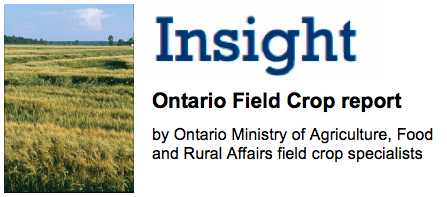Canola/Edible Beans: Brian Hall
Canola: Planting is 95 % complete in southern growing areas and nicely started in northern districts. April planted fields are at cotyledon-1st leaf stage. Flea beetles are now actively feeding. Populations are highest in field borders. Threshold for control is 25% leaf feeding. Weeds are emerging with the canola. Critical weed control period is 1- 4 leaf stage. Schedule weed control for early stages to protect yield and avoid weather or other delays.
Edible Beans: The optimum planting date for edible beans is late May–early June. Planting before this date risks beans flowering and setting seed when higher temperatures and lower rainfall are more likely. Burndown herbicide application can assist with perennial weed control.
Cereals: Peter Johnson/Scott Banks
Winter wheat is advancing rapidly with warmer temperatures. The window for herbicide applications is closing as fields reach flag leaf stage. Flag leaf herbicide applications run a high risk of crop injury. If weeds are a harvest issue, pre-harvest glyphosate is the best option on advanced fields. Early wheat at Harrow is just beginning to head (GS 50). The crop is 1- 2 weeks ahead of normal development. Cool night temperatures through stem elongation will result in a shorter crop, which should help reduce lodging problems. Disease pressure remains low, with powdery mildew beginning to ramp up in lush fields and susceptible varieties. Timing is excellent for the first fungicide spray, if two applications are planned.
Spring cereals have jumped over the last week, with early fields well into tillering (GS 23-25). Weed control is becoming critical for maximum yield. Disease pressure remains very low.
Corn: Greg Stewart
Corn planting ranges from 50 to 95% complete; provincially corn planting is estimated at 80%. In most areas rainfall has not been intense and soils remain in good shape despite large acreages without significant residue cover. Corn requires about 180 CHU to emerge. Corn planted April 16 - 20 is emerging this week. Most reports suggest that emergence and seedling vigour are good; earlier planted corn that had tissue damage from cold temperatures is recovering.
Nitrogen application using UAN (28%) will cause some corn leaf burn, but impact on yield is usually negligible. Guidelines for post-emerge UAN application: 1) UAN (fan nozzle) and herbicide– max. 2 leaf corn, 2)UAN (fan nozzle) no herbicide - max. 3 leaf corn.
Forages/Pastures: Joel Bagg/Jack Kyle
Forages: Anticipated yields and maturity of the forage crop are extremely variable across the province. Cutting according to a calendar date may not result in optimum forage quality. Early growth in March, followed by cool dry weather means that frost damaged growing points had to form new crown and auxiliary buds. Weak, diseased stands have also been slow to green-up and develop, and will have a greater proportion of grass and dandelions. Growing Degree Day models are unlikely to be very accurate. Dairy producers should consider doing some “scissors-cut” sampling and rapid laboratory analysis to predict optimal harvest dates.
http://fieldcropnews.com/?p=2610
Closer examination by digging plants, show many of these fields are experiencing crown and root rots, including brown root rot http://bit.ly/omafraforages7.
Contributing risk factors include: older stand age, poorly drained soils that were saturated last fall, and fields that were harvested during the Critical Fall Harvest Period. Plant health in these disease infected stands will continue to decline. Both diseased and frost damaged stands will suffer reduced yields. Forage inventories are expected to be tight in many areas. Assess fields and pastures and make forage inventory, crop rotation and alternate forage andn plan accordingly http://bit.ly/omafraforages8
Pastures: Warm temperatures and showers will result in rapid growth during the next few weeks. First rotation management will set the stage for remainder of the season. Leaving 7 - 10 cm of grass after grazing will allow for rapid regrowth and the development of a strong stand. Grass based pastures will respond to an early June nitrogen application of about 45 kg/hectare N.
Soybeans: Horst Bohner
Planting progress has been slow over the last week although a few areas did make headway. Less than 10% of the crop has been planted to date. Soil potassium levels have slipped in Ontario with estimates that up to 20% of Ontario fields may be below ideal levels for soybeans. Applying potassium in the spring before planting is an acceptable practice for fields with low soil test levels. Any field with less than 10 ppm K in soil test results may suffer significant yield losses, especially in dry years. A 50 bu/ac crop removes about 70 lbs/acre of potassium. Glyphosate burndowns should be applied 5-7 days before planting to ensure adequate translocation into perennial weeds. If perennial weeds are getting large (12.5 cm (5") or taller), increase the rate of glyphosate. If annual weeds are the target, a 3 day pre-plant interval is adequate.



